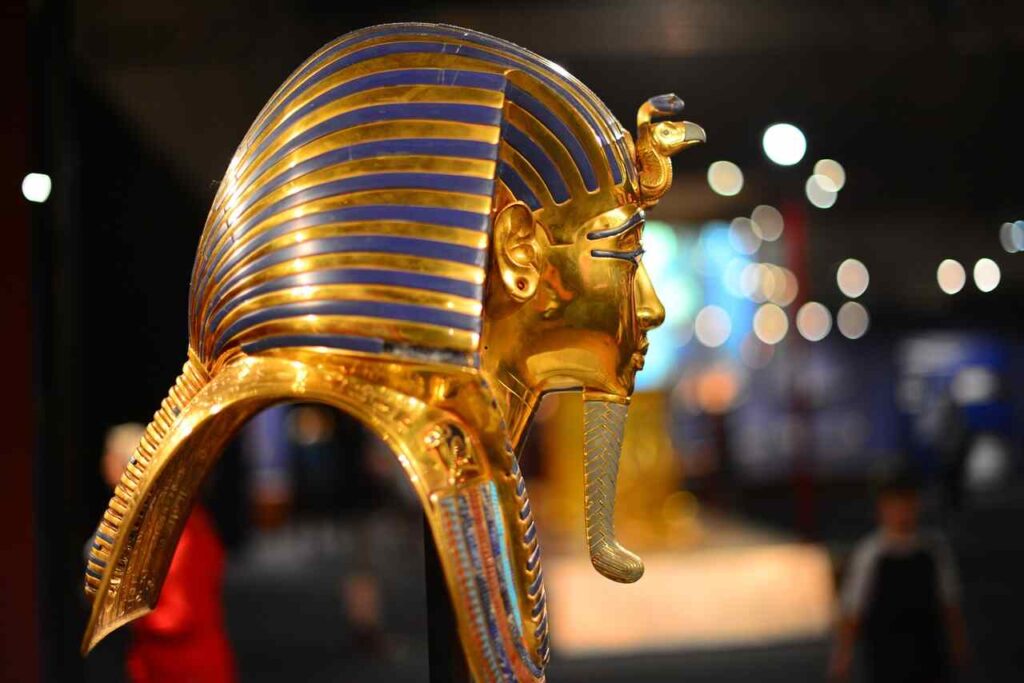In 1922, British classicist Howard Carter made a momentous discovery in the Valley of the Kings: the almost intact tomb of the ancient Egyptian pharaoh Tutankhamun. The youthful ruler, who climbed to the lofty position at only nine years of age, immediately turned into an unbelievable figure in the realm of paleontology. However, since the discovery of his tomb, questions have emerged about the circumstances surrounding his death. A few scholars have even proposed that King Tut may have faked his own death to escape the tensions of administering ancient Egypt.
1. The mysterious life and death of King Tutankhamun.
King Tutankhamun, otherwise called King Tut, is one of the most popular pharaohs of ancient Egypt. Notwithstanding his short rule from around 1332 to 1323 BC, he has caught the imagination of people all over the planet for quite a long time. Tutankhamun became Pharaoh early on, conceivably as young as nine years of age, and governed for simply under 10 years before his abrupt and mysterious death.
The discovery of his tomb in the Valley of the Kings in 1922 by British excavator Howard Carter ignited a restored revenue in ancient Egypt and its fortunes. The tomb was basically intact, in contrast to numerous others that had been stolen from throughout the long term, giving us an uncommon look into the life and death of this youthful king.
One of the most charming aspects of King Tut’s life is the mystery surrounding his death. While the exact reason for his death is as yet bantered among researchers, many believe that he died unexpectedly early on, perhaps because of disease or injury. However, some paranoid ideas have arisen throughout the years, proposing that King Tut may have faked his own death.
The possibility that King Tut may have staged his own death is largely founded on the absence of a reasonable reason for death and the mysterious circumstances encompassing his burial. Some believe that Tutankhamun might have needed to escape the tensions of administering as a youthful king and decided to fake his own death to experience the remainder of his life in obscurity. Others propose that he might have been engaged in an epic showdown inside the imperial court and staged his death as a method for getting away from likely threats to his life.
Notwithstanding these speculations, there is minimal, substantial evidence to support the possibility that King Tut faked his own death. The discovery of his tomb with its luxurious fortunes and elaborate burial customs implies that he was, to be sure, a genuine pharaoh who was grieved and respected in death by his subjects. The ancient Egyptians had elaborate convictions and practices encompassing death and the afterlife, and the consideration taken in planning King Tut’s tomb demonstrates that he was given a legitimate burial as per these traditions.
While the secret encompassing King Tut’s death keeps on interesting researchers and enthusiasts alike, moving towards these speculations with a basic eye is significant. Without strong evidence to support the possibility that he faked his own death, it remains more probable that King Tut died early on under unknown circumstances.
2. Speculations recommending that King Tut could have faked his own death to escape political enemies.
One charming hypothesis that has arisen with respect to the death of King Tutankhamun is that he could have actually faked his own death to escape his political enemies. This hypothesis is supported by a couple of key bits of evidence, in spite of the fact that it is still exceptionally speculative and dubious.
One justification for why a few historians and researchers believe that King Tut may have faked his death is the mysterious circumstances encompassing his burial. Dissimilar to different Pharaohs who were covered in fabulous tombs with intricate enhancements and fortunes, King Tut’s tomb was moderately little and basic in correlation. Some contend that this proposes a rushed burial, conceivably demonstrating that he didn’t actually pass on when it was accounted for.
Moreover, there is evidence to suggest that King Tut may have been confronted with political threats during his rule. Verifiable records show that he made a few strong enemies inside his court, including individuals from his own family who might have competed for power. Conceivable confronting an up-and-coming risk, King Tut chose to fake his own death to escape his enemies and live in banishment.
Moreover, a few researchers highlight the absence of obvious proof of the reason for King Tut’s death as motivation to suspect injustice. While certain speculations recommend that he died from normal causes, others suggest that he might have been killed. This vagueness encompassing his death has led some to guess that maybe he staged his own destruction to lose any expected professional killers.
One more fascinating piece of evidence that supports the hypothesis of King Tut faking his death is the discovery of a second mummy in his tomb. In 2015, scans of King Tut’s tomb uncovered the presence of a formerly unknown mummy, believed to be that of Sovereign Nefertiti. A few researchers hypothesise that maybe King Tut and Sovereign Nefertiti faked their deaths together to escape from their enemies and begin another life somewhere else.
While these bits of evidence are captivating, moving towards this hypothesis with caution is significant. The possibility that King Tut faked his own death is still exceptionally speculative and needs substantial confirmation. Similarly, as with numerous verifiable mysteries, reality might very well never be known beyond a shadow of a doubt.
3. Evidence supporting the hypothesis, like inconsistencies in his burial and the absence of a reasonable reason for death.
There are a few convincing bits of evidence that support the hypothesis that King Tutankhamun might have faked his own death. One of the central issues in dispute is the alleged inconsistencies encompassing his burial. At the point when Tutankhamun’s tomb was found in 1922 by Howard Carter, it was viewed as moderately small and hurriedly ready. This was amazing, taking into account that Tutankhamun was a pharaoh, and normally pharaohs were covered in extreme tombs with intricate designs and burial products.
Besides, the fact that Tutankhamun was covered in a tomb that was initially expected for another person raises doubts. The engraving on his stone casket demonstrated that it was initially made for an alternate pharaoh named Ankhkheperure Neferneferuaten, persuading some to think that Tutankhamun might have assumed control over the tomb and its items to stage his own death.
One more confounding aspect of Tutankhamun’s burial is the absence of an unmistakable reason for death. Notwithstanding broad exploration and examination, including a CT scan of Tutankhamun’s mummy in 2005, specialists have not been able to conclusively decide how the youthful pharaoh died. While some believe that Tutankhamun might have died from an infection or injury, others estimate that his death was not normal and may have been important for a bigger arrangement to fake his own destruction.
Furthermore, there are inconsistencies in Tutankhamun’s embalment cycle that have caused a commotion. For instance, evidence suggests that his heart was eliminated from his body, which was surprising for ancient Egyptian embalment practices. Some believe that this might have been a conscious endeavour to make it seem like Tutankhamun died from a heart-related issue, further supporting the hypothesis that his death was staged.
Besides, the fact that Tutankhamun’s death was followed by a time of vulnerability and political commotion in ancient Egypt lends belief to the possibility that his death might not have been what it appeared. After Tutankhamun’s rule, his replacements took incredible measures to delete his memory from history, persuading some to think that it was all important for a bigger arrangement to propagate the deception of his death.
All in all, the evidence supporting the hypothesis that King Tutankhamun might have faked his own death is huge and brings up many issues about the genuine circumstances encompassing his destruction. From the inconsistencies in his burial to the absence of an unmistakable reason for death, there are many factors that suggest that Tutankhamun’s death might have been staged. While we might in all likelihood never know reality for certain, the likelihood that Tutankhamun faked his own death adds one more layer of mystery to the generally puzzling tradition of this ancient Egyptian pharaoh.




